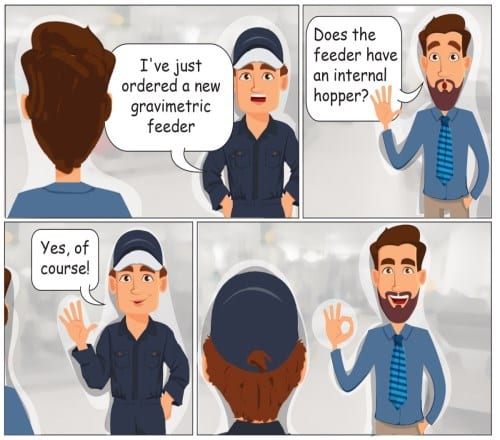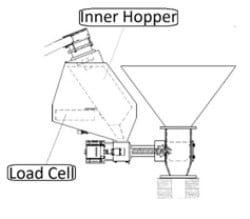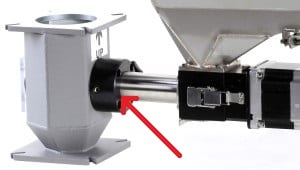
The ColorSave 1000 is known as the best gravimetric feeder on the market. Beyond the advanced algorithms used by the feeder, the convenient user interface, and easy operation, the ColorSave 1000 has an additional significant advantage – an internal weighing hopper.
The weighing hopper (including its load cell) is within an outer container, so the weighing apparatus isn’t visible from the outside, making the ColorSave 1000 look like a volumetric feeder at first glance, rather than a gravimetric feeder.
The weighing hopper is mechanically isolated from the rest of the system – the auger and its mechanism, the motor, the pumping mechanism, outer tubes, connecting cables, etc.) The mechanical isolation of the weighing hopper is one of the patented solutions used in the ColorSave 1000.

Figure 1: Inner hopper and load cell
1) Much higher sensitivity and accuracy
In the ColorSave 1000, the load cell weighs only what needs to be weighed – the additive alone – as opposed to other feeders that weigh the full mechanical system, including the heavy motor, the auger, and the feeding mechanism. When there’s no weighing of the extra, unnecessary heavy items, but only the additive, you can achieve a much higher weighing resolution, with super-accurate results.
2) Prevention of random touches that could affect the weighing
It’s well known that the load cell is a highly sensitive component. Any random touch by someone or something on the load cell or a component attached to the load cell during the feeder’s operation affects the weight sensed by the load cell and may cause errors in the gravimetric algorithms used by the feeder. In the ColorSave 1000, the load cell is protected, precluding random touch that could affect the weighing process.
3) Mechanical protection of the load cell
Every load cell has a maximum load, above which it could be ruined. With an unprotected weighing hopper, any external pressure on the hopper from a heavy tool or the operator’s force could wreck the load cell. For example, during the transfer of the feeder from one machine to another or to storage, something might push against it, or an operator climbing on a production machine during maintenance might lean on the feeder, exerting too much pressure on it.
In the ColorSave 1000 the load cell is covered by the outer container, protecting it from external pressure and impact or from the operator’s lack of caution.
4) Separation from the loading mechanism
Due to the fact that the ColorSave 1000’s weighing hopper is mechanically isolated, you can install any kind of loader (Venturi or even motorized) directly on the system without affecting the quality of the weighing process. In order to install a loader on other feeders that don’t have an isolated weighing hopper, there’s a need for complex mechanisms to prevent interference with the weighing process, usually only a Venturi loader can be used, and that, too, could affect the weighing process if not installed properly.
5) External connections don’t affect the weighing process
Every feeder has external connections, such as electrical and control cables, air supply tubes, tubes for loading materials, etc. These connections are liable to affect the weighing mechanism and result in inaccurate dosing.
Due to its mechanical isolation, the ColorSave 1000’s weighing system is not affected by these external connections, since they are connected to other parts of the feeder and not to the weighing mechanism.
6) There’s no gap between the feeder and the production machine’s throat
Since in competing feeders the weighing mechanism is not isolated from the rest of the system, a space must be left between the feeder and the production machine’s throat to keep the feeder “floating”. The space is a source of trouble – dust contamination or interference in the weighing process by grains of masterbatch that get into the space.
Since the weighing container in the ColorSave 1000 is isolated, there’s no need to leave a space between the feeder and the production machine’s throat.

Figure 2: No gap between feeder and throat
Speak directly with our engineers and find ways to reduce cost, inventory and time
Request a Demo© Copyright Ampacet Corporation. All Rights Reserved